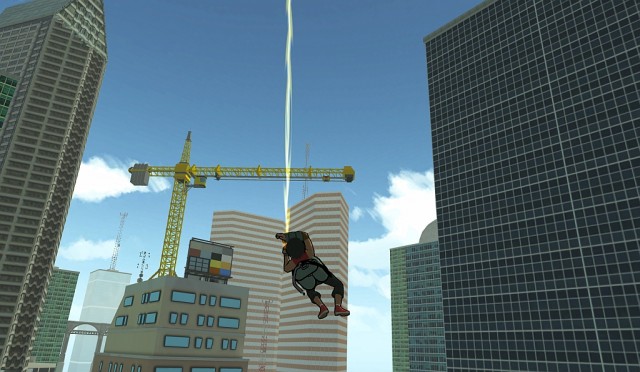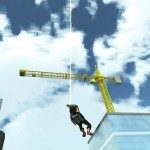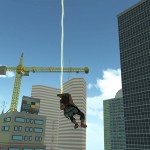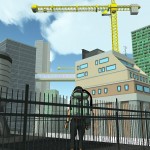
Jamie Fristrom is a name that you might not be familiar with, but you’ve certainly experienced his work. In 1996, Fristrom became part of the original team at Treyarch and had a hand in many of their earliest hits. But his biggest claim to fame is the creation of the webslinging engine found in Spider-Man 2 (and used in nearly every Spider-Man game since). In that dark period between GoldenEye 007 and Batman: Arkham Asylum, Fristrom’s work on Spider-Man 2 proved that licensed games could still be fun.
After his days at Treyarch ended, he went the indie route and created the acclaimed XBLA game Schizoid and founded his own one-man-studio, Happion Labs. His first game under the Happion Labs banner will be Energy Hook, a game that attempts to recapture the fun we all found in aimlessly webslinging around Manhattan.
Fristrom is readying a Kickstarter campaign to help fund the game, which will likely launch in a few weeks. In the meantime, I had a chance to talk to him about his career so far and where he plans to take it with Energy Hook.
John Scalzo, Warp Zoned Editor-In-Chief: You’ve been making games longer than some of today’s Call of Duty players have been alive, how different is game development now versus then?
Jamie Fristrom: One thing that I still can’t get over is how powerful the free tools are. Unity + Gimp + Sketchup is more powerful in a lot of ways than the tools we made Spider-Man 2 with – and all free.
WZ – John: It’s like that old joke about the iPhone being more powerful than the computers NASA used to get us to the moon in 1969.
Fristrom: Totally. I could actually spend all day on [this] question.
I suppose I should mention that I’ve seen indie game development die and come back. Back around the time of Doom indie game development was a thing. Id was an indie. We didn’t call it “indie,” but the studios that were marketing and distributing their own games were exactly that. Then people started considering indie game development as bad business – the publisher model became The Thing To Do. “We’ll show our prototype (or even just design document) to publishers, get funding, and make a game with No Risk!” Publishers were more free with their funding back then, and id was the only indie that had made it big. It was hard to distribute back then. You had to send discs out yourself like Introversion did, and it was hard to get noticed, so I suppose it makes sense that being indie was unpopular.
Then with new channels that made it easy to distribute and a few big success stories, suddenly indie became a Thing. And anybody who wanted more creative control over their games wanted to try it. I know I did. We do seem to be entering a post-gold-rush phase now, where very few studios are actually able to get to a point where they can pay the bills and feed their families, but the low cost of entry means that lots and lots of people are at least giving it a shot – and that’s cool. Ten to fifteen years ago, if [someone] wanted to be a game maker, that meant [you] wanted to get a job at a studio being a cog in the machine. Now [everyone] can just be game makers.
It probably won’t make us rich, but we’re doing what we like to do.
WZ – John: I’ve seen Draconus: Cult of the Wyrm show up on a few “Most Underrated Dreamcast Games” lists. What is it about that game that people seem to love?
Fristrom: Actually, Draconus isn’t one of my faves. The key thing for Die By the Sword [ed. Draconus is actually Die By the Sword 3], for me, was the amount of control you had over your character – you were like a marionette operator. With Draconus we took that out, made it all canned animations, like every other brawler out there. So when people tell me, “Man, I loved Draconus” I mostly chalk it up to the great art.
WZ – John: Your biggest contribution to gaming is obviously the webslinging engine from Spider-Man 2. What exactly made the webslinging in Spider-Man 2 so unique and different from previous Spider-Man games?
Fristrom: Previously, Spider-Man games were like the first cartoon from the early seventies… You weren’t sure what his webs were attaching to exactly [and] you tried to pretend that there must be some really tall building just out of sight, but you had to really strain your disbelief. So when working on Spider-Man, that literally kept me awake nights, thinking about some way to make it more “realistic,” but without making it too hard to control.
A little known fact is that I started prototyping [the webslinging engine] about a third of the way into Spider-Man 1, but we’d already progressed so far on that game it was too late to switch horses. So we put it on the back-burner until Spider-Man 2 and then got to really make it happen.
WZ – John: Did you expect the kind of reaction you got? More than a few publications have declared Spider-Man 2 one of the greatest games of all time just on the strength of the webslinging alone.
Fristrom: We all thought it was really cool. The testers loved it. I don’t know about “greatest games of all time,” but we thought we had something special. Our biggest worry was that it was still too difficult to control – that we were making a game for an audience that just wanted a game to go with their movie, and that they wouldn’t want to put in the effort to get past the learning curve.
WZ – John: With its inclusion in practically every Spider-Man game since, I would guess that gamers got used to it.
Fristrom: I hear they finally moved away from it, with the last one, Amazing Spider-Man, and are doing a more Arkham City like thing, where you just press a button and it swings for you. And I get it. Probably most people who just want a movie-game want that.
That’s what’s great about being indie now. I don’t have to make a game that everybody likes – I can have a small niche audience that’s into what I’m into.
WZ – John: What made you want to move away from the big studios and into the indie development space?
Fristrom: There were a whole bunch of factors that built up. I was one of two creative directors on Spider-Man 3, and you’d think with such a hifalutin’ title I’d have a lot of creative control. But I didn’t – trying to get upper management and a team of a hundred people to buy into my ideas was beyond me. And I really like getting my hands dirty. In the code, making stuff.
WZ – John: Do you think this “too many cooks in the kitchen” mentality is what doomed Spider-Man 3 critically?
Fristrom: There was a ton of turnover after Spider-Man 2. [Creative Director Tomo Moriwaki] left, [Art Director] James Chao left, I left … and the cool stuff we’d come up with before we left – Tomo’s new combat system, some stealth stuff I worked on – was abandoned by the new guard. It ended up being a game that didn’t take any risks and was not only unremarkable but frustrating.
Plus the movie sucked. Plus quick time events.
WZ – John: Yeah, I love Sam Raimi, but Spider-Man 3 was not his finest hour. I can imagine the rage over the movie spilled over into pot shots against the game.
Fristrom: Word. He kind of publicly disavowed it himself, didn’t he?
WZ – John: He’s made it very clear that the movie he wanted to make didn’t involve Venom in any way. He wanted Vulture, I believe.
Fristrom: I’m a Venom fan but that movie was a trainwreck.
WZ – John: Word.
WZ – John: Activision is viewed by many as the “Evil Empire.” Is it safe to say you got a similar feeling from the inside ten years ago?
Fristrom: No, actually, this was back in the days when EA was still the evil empire. Those of us who left weren’t disgruntled as far as I know. Our contracts were up, and I, for one, just wanted to do something else. Activision had gotten rid of the founders of Treyarch in a similar way as they later would do with Infinity Ward, but there wasn’t much rancor afterwards, no lawsuits or anything.
WZ – John: After Activision you made Schizoid for the XBLA. Schizoid seems to share a bit of DNA with Treasure’s Ikaruga. Was that an inspiration for you?
Fristrom: I’d heard of Ikaruga but hadn’t played it – I didn’t actually get to play it until it came out on XBLA. Maybe hearing about Ikaruga had influenced me subconsciously, but I think it came more from pure game design theory – the idea that having units with orthogonal powers is interesting.
WZ – John: Wow. So what has inspired you over the years?
Fristrom: At some level I just like making stuff. Schizoid evolved. It started as, “What would happen if you controlled two guys at the same time with one controller?” And the answer was, “You get a game that only Jamie likes.” Though that later lived on as ‘Uberschizoid’ mode.
Sixty Second Shooter, on the other hand, is pure homage and mash-up. “What would happen if we combined Geometry Wars and Bejeweled Blitz?”
And Energy Hook, I guess, is nostalgia. I just really loved that core swinging mechanic and missed it.
WZ – John: What happened during the development of Energy Hook that made you want to set up shop as a “one man studio” a la Dean Dodrill or Phil Fish or Jonathan Blow?
Fristrom: When I decided to make Sixty Second Shooter for Chrome’s new native client technology I didn’t have an easy way to import art assets into the game. It was easier for me to generate them procedurally. So I decided to just see if I could make a whole game by myself without a real artist’s help. Something I hadn’t done since college, and even then only as a hobby project. Which was enormously empowering.
Coming from AAA I was still working under the spectre of the idea that you need a specialist to do everything. A texture artist to do your textures, a sound engineer to create your audio, a level designer to build your levels, etc.
I could make Energy Hook by myself if I had to, but fortunately Paul Whitehead is helping me out and it looks a lot better for it.
WZ – John: Do you think a lot of these one-man-games come about because the creators just want to see if they can do it?
Fristrom: I think a lot of it is also that there isn’t much money in indie games on average – although the biggest names in indie games make millions – the names that are merely kind-of-big don’t, and splitting the revenue amongst a large team means you can’t pay the bills.
WZ – John: That makes sense.
WZ – John: For those that have never heard of it, sell the world on Energy Hook.
Fristrom: Fortunately, I don’t need to sell the whole world – I only need to sell it to those gamers out there that love grappling-and-swinging games. I don’t know how many of us there are, but for some people, there’s just something about the idea of throwing yourself off a tall building on a wire and then swinging dramatically through the air – it’s visceral and dramatic.
So how do you make a game out of that? We’re taking pages from Tony Hawk and SSX – having freestyle modes where you swing around and do tricks for points, and having race modes where doing tricks earns you energy to give you boosts to go faster.
WZ – John: Energy Hook has a grapple gun and a jetpack. Are you planning to include any other superhero-like gadgets in the game?
Fristrom: You also have these gravity boots – you can run on ceilings. But that’s it. I’m thinking more in terms of powers than gadgets. Will you be able to glide? Slide on rails? Maybe you’ll be on some kind of hoverboard for that, or maybe your boots will be like gravity-powered inline skates
WZ – John: What kind of challenges will Energy Hook ask of players?
Fristrom: While working on Spider-Man I had all these level design ideas that didn’t work, because he could just crawl anywhere.
WZ – John: But now with a jetpack and a grapple gun and anti-grav boots, getting somewhere is more work.
Fristrom: Exactly. They’re limited. After you jump there’s a cooldown on your jetpack and your gravity boots only let you run upside-down for so long, etc.
WZ – John: So not at all like organic webshooters!
WZ – John: How do you think you’ll be able to expand Energy Hook after a (fingers crossed) successful Kickstarter campaign?
Fristrom: A lot depends on the Kickstarter. The more funding we can secure, the more we’ll do. But obvious ways. More levels. More worlds. More challenges. By ‘worlds’ I mean levels where the geometry looks clearly different – in Metroid you might have your lava and ice levels – in Energy Hook it might be your night city and your sky city.
WZ – John: Will any of the cities be based on real-life locales?
Fristrom: No… that can be the enemy of fun. A restriction I’m happy to get away from. If I want a level where you have to jump off a platform, swing from a bar to get to a higher platform, I don’t want to be told “There isn’t anything exactly like that in Manhattan.” Fun first.
WZ – John: Fun first. I like it. Thanks Jamie!











